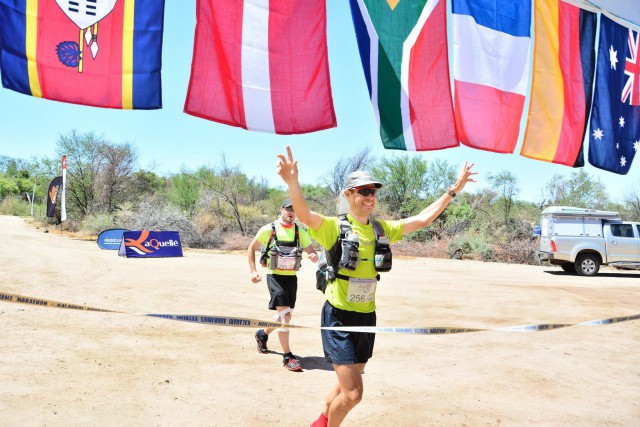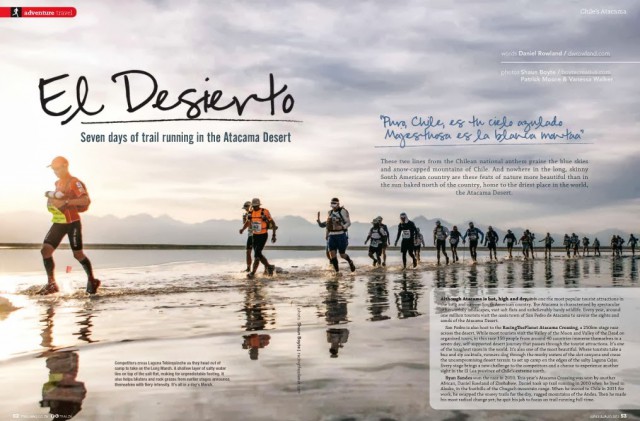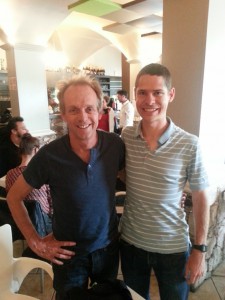Recently Global Advisors hosted multi-stage ultra-marathon runner Daniel Rowland as he gave a talk about his training and racing approach. The talk happened prior to Daniel racing in the Kalahari Augrabies Extreme Marathon 2013 – a 250km multi-stage race that takes place over 7 days through the extreme heat and difficult terrain of the Kalahari Desert. Competitors carry their own food, bedding, etc – water and sleeping tents are provided.

Daniel Rowland winning the Kalahari Augrabies Extreme Marathon 2013 (picture Hermien Webb Photography, Facebook)
Daniel won in a course record time. Earlier this year Daniel won the Atacama Crossing – another 250km multi-stage self-supported desert race across the Atacama Desert (the driest place on earth) and part of the prestigious Four Desert Series. The Four Desert Series attracts some of the finest Ultra-Marathon athletes in the world who compete only for the prestige – there is no prize money. These two races are Daniel’s first two multi-stage races in his first year as a professional runner.

Daniel Rowland leads the Atacama Crossing 2013 field en-route to victory (Picture Shaun Boyte in Trail Magazine Issue 7 – dwrowland.com)
There is no doubt that Daniel is a talented sportsman – he represented Zimbabwe as a triathlete and trained as a potential Olympian. But there are many talented athletes that fail to achieve sporting success. What makes Daniel as successful as he is?
Daniel abandoned his Olympic ambitions to study a Business Science degree at UCT. He was selected as a McKinsey intern. Following this he went on to work for Anglo American in South Africa, Alaska and Chile. Two-and-a-half years ago, Daniel entered his first ultra-marathon beyond 50km – the 100 mile Sustina race through the depths of the Alaskan winter, battling snow and night. Daniel finished fourth. Following Daniel’s blog (www.dwrowland.com) as an interested spectator and recreational runner with no real ambitions of running an ultra myself, I was struck by the regimen that Daniel adopts to life in general and running in particular. Even in his early ultra exploits, Daniel exemplified a simple approach that underlies most key management theory – Plan, Do, Review (PDR).
Plan appropriately for the execution against the goals that you aim to achieve, Do what you planned to and Review your execution against the plan.
This is not a once-off process – it can be repeated many times within a broader cycle and even within execution itself. Organisations might set five year strategies and budgets and then repeat the cycle on a yearly, quarterly or even short interval basis (for example, agreeing and reviewing plans at the beginning and end of shifts – a process typically referred to as short-interval controls). A rugby team might agree a game plan and evaluate its success during stoppages and breaks.
The PDR cycle is followed either consciously or subconsciously by outstanding performers in every field from arts to sport to business. It is a discipline. And like all disciplines it takes practice and fine-tuning to meet the needs of individuals and companies.
Daniel exemplifies the approach. He chooses a goal that is aligned to his interests and who he inherently is. He chooses a race goal and works backwards to fit in all the aspects of training, testing and recovery. He prepares a tailored program with his coach based on his knowledge, Daniel’s input and past performance. Daniel describes execution as doing what he knows he needs to do to achieve his goals.
Daniel is fastidious about all these aspects. He trains in blocks that ramp up to race distances and conditions. He tests all aspects of race conditions, including the diet he will live on in the desert, with the exact pack and equipment he will run with and in conditions on the race course or as close to these as he can find. His approach to optimizing his back pack illustrates this.
Daniel’s Augrabies pack weighed 6kgs and included 3,6kgs of food. Most of his competitors’ packs were 10kg or more. To accomplish the optimum pack weight required much more than selecting equipment against a recipe. He chose a pack that was lightweight and that he found comfortable. He trimmed excess strap lengths. He took the required equipment list (things like eating and cooking utensils, emergency equipment, etc) in their most minimally adequate form. He created a race diet that had the highest calorie to weight ratio possible. And he trained with the pack and on the diet, gradually tuning his choices and becoming utterly familiar with the diet and running with the pack for the periods and conditions matching those of the race. He blogs about all of his choices and tracks progress with data from his heart rate monitor supplemented with his logs of how he felt and his thoughts on what worked and what could be improved.
Every two weeks, Daniel runs a test on the same 12km route, in the same heart rate zone with the same pack weight and as-close-to-optimal body weight. He tracks his time on the test for improvement over the 30 week program leading up to a race.
While Daniel is clinical about the technical aspects of a race, he recognizes the critical importance of emotions – confidence and enjoyment are key to his success. He underpins what he does with a healthy and sustainable lifestyle. This includes enough sleep and recovery time and the community he surrounds himself with. Besides the general community of friends, Daniel’s core team is made up of people he trusts and who create confidence for him because they are present and contributing with a collective goal in mind. This team is comprised of his partner, coach and sponsor – a small and completely trusted core team.
It is an impressive routine and discipline for someone who not long ago, started out training in the very early hours of the morning prior to a demanding corporate job. All the discipline would mean little without stressing himself to the optimum level, and showing incredible willpower and drive. Daniel has willpower and drive in bucket-loads. What stood out to me is that while a level of willpower and drive is a product of who we are, Daniel manages this aspect carefully too. He takes care to push himself enough to develop greater levels of performance while managing the risk of illness and injury – an optimal stress level. Technical training, emotion and health all contribute to setting this optimum. Daniel recognises willpower is a limited resource and ensures he makes focused use of his reserves through routines and removing obstacles. He creates drive through seeing the excellence in others, momentary inspiration, his enduring motivation and the performance of competitors.
When Daniel left Global Advisors after his presentation, we were in little doubt that Daniel had done everything he could to prepare for the Augrabies race. We were confident he stood every chance of winning the race. But more importantly, so did Daniel – in his quiet, unassuming way.
Pick up most management books or business textbooks and you will find the PDR elements described above. We see them in place in the best businesses and clients. They are expressed in tools such as well articulated strategies, balanced scorecards, project management approaches, management and financial reporting. What is far more difficult than the adoption of a set of tools is the institution of the accompanying processes and culture. Discipline is hard enough for an athlete – successfully inculcating the PDR disciplines in a corporate setting requires strong leadership with a soft touch. It relies as much on the belief and cooperation of the team as a well-thought out approach. Just as hard as it must be for Daniel to ensure he preserves the space around him for a community that reinforces his process, beliefs and spirit, it is unbelievably hard to do the same in a business setting. My personal experience is that successful leadership requires walking a fine line between creating and implementing an optimal PDR approach / culture and creating some space to allow those who fit within that culture to find a place within it. That won’t always work out. You will lose some good people along the way as well as those who don’t belong. It is critical to ensure your team sees the benefits of your chosen PDR approach to ease their journey. It takes time – years – for the PDR approach and culture to develop a rhythm, The role of a core supportive team at a management level or on a project is critical to reinforce the PDR disciplines and build confidence. Daniel believes in “controlling the controllables” – the role of his core team illustrates this.

Daniel Rowland meeting Bruce Fordyce after his Kalahari Augrabies Extreme Marathon win (picture from @brucefordycerun on Twitter)
Daniel’s approach is not unique in its elements. Bruce Fordyce famously kept detailed notebooks of his training and races and was meticulous en-route to nine Comrades victories, the London to Brighton Marathon three years in a row and the 50 mile and 100km world records. He too focused on a holistic approach and kept mood records along with the details of his technical performance.
What I have become convinced about is that just as a management / PDR approach is required to prepare and practice for execution, so the approach must be applied and finely tuned over time. As I watched another amazing Kenyan marathon performance, I tweeted how ridiculously easy the lead runners ran at below 3 minutes to the km. Elana Meyer responded, “Practice makes excellence in action look easy.”
Daniel Rowland, Bruce Fordyce and Elana Meyer are inspirational examples of the power of a well-executed PDR process in sport. The same process exists in a well-executed dance routine, well-written academic career and of course in winning businesses.
What is your approach to running your business? How does it incorporate Planning, Doing and Reviewing? Would your approach support the creation and maintenance of a world-class athlete? Is your PDR approach communicated and understood? Is your culture supportive of the approach? Are you practicing the approach and adapting it for your company? What is the PDR mood?
Daniel is racing the Sahara Race (part of the Four Deserts series) in February 2014. You can follow his progress on the Four Deserts website or on Daniel’s blog.
This photo essay of the Atacama Crossing 2013 by Richard Bray will give you some idea of the challenge posed by multi-stage desert running and Daniel’s accomplishments.


